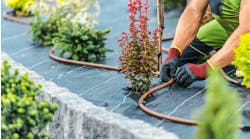Plumbing contractors play a vital role in every project they’re a part of. Plumbers are often highly valued not just for their practical skills but their contributions to comfort and public health. But professionals in the field are starting to do even more. Increasingly, they’re taking actions to positively impact the environment.
There is a growing need and demand for sustainable buildings. This may be developing from the ground up or converting existing properties to meet higher standards. Certain aspects of plumbing support the holistic sustainability of properties. It’s vital to be aware of these and some of the emerging technologies so you can provide clients with better access to sustainable homes.
Let’s explore a few of the current green plumbing innovations available.
Using Green Materials
Throughout the recent history of plumbing and construction, there have been revelations that the materials being used are not positive either from a health standpoint or for the impact on the natural landscape. For instance, we no longer use lead pipes due to personal health consequences and wider ecological toxicity. One of the focuses in plumbing at the moment is the continued use of more sustainable and healthy materials.
Perhaps the most prevalent issue is finding alternatives to polyvinyl chloride (PVC) piping. This type of piping is notoriously unsustainable, emitting toxic chemicals during production alongside being non-biodegradable. Certainly, clients can use copper pipes that offer greater sustainability, as they are cleaner to manufacture and have a significant lifespan. However, copper is also expensive. Alternative mataerials are now coming into use such as clay, glass and even Linoleum pipes (which are biodegradable).
That said, it’s also important to understand how advances in green construction might also impact choices of plumbing. More clients and contractors are favoring sustainable alternatives to concrete to make projects more holistically environmentally sound. Materials like ashcrete—made from fly ash waste products—and hempcrete perform in much the same way as traditional concrete but are less damaging to produce. Plumbers could encounter these alternative concrete materials as they are used to cover plumbing groundworks. The lightweight nature of these materials may make it easier to access underground piping for repairs and upgrades.
However, other materials like mycelium may require some additional consideration from plumbing professionals. Mycelium is robust and lightweight and is technically still living, which makes it self-healing. Nevertheless, it may require piping material choices that are fungus and mold-resistant to prevent the materials from building up on the pipes, entering the system, and causing potential issues. When encountering new green materials, it’s important to collaborate with building contractors to better understand the materials used to you can help clients make informed decisions on what type of maintenance is needed.
Leveraging Technology
Increasingly, advanced tech is playing a role in making plumbing more ecologically friendly. It’s important to raise the potential of these tools when discussing projects with clients, ensuring they are getting opportunities for greater sustainability.
Many of the latest sustainable trends in plumbing utilize advanced technology to reduce negative impacts and save money. Just two of these trends are:
● Smart plumbing systems: The Internet of Things (IoT)—an eco-system of interconnected devices sharing data—is one of the most fascinating aspects of the digital landscape. It’s also central to smart plumbing systems. In essence, sensors are placed throughout the pipes and plumbing fixtures. These send data on water flow to analytics software, enabling the system to detect anomalies that suggest leaks, drips, and other issues. The homeowner is usually alerted via a mobile app, which allows them to address the causes efficiently, minimizing water wastage.
● Solar water heating: Water heating systems are essential for baths, showers, and kitchen faucets. However, as they’re often powered by non-renewable energy, they put pressure on the environment. Solar-powered water heaters reduce reliance on these sources. A solar collector is installed—usually on the home’s roof or in the yard—which collects heat that gets transferred to the water tank. These systems are not just energy-efficient. Many solar heaters, particularly those using natural water cycling methods, are low maintenance. As a result, parts rarely need replacing, making for greater longevity and efficiency.
Contractors should keep on top of the new advances in eco-friendly plumbing technology. This can for clients wanting to minimize their negative environmental impact.
Recycling Water
Responsible water use is one of the primary concerns at the moment. Water scarcity is a serious issue that is being made worse due to the onset of climate change. It is vital for plumbing contractors to help clients and their families establish methods to reduce unnecessary wastage and fend off the negative effects of shortages. One approach is to install systems that recycle water.
Just now, the main focus is on greywater recycling. This involves collecting water that is drained from showers, hand basins, kitchen skins, and washing machines so it can be used again. While greywater isn’t suitable for drinking, it can be used for watering gardens, flushing toilets, and cleaning laundry. As a result, it puts less pressure on already stretched water resources.
There are a growing number of ways to make this practical. Most involve installing tanks in the basement, garage, or other area to collect and filter water from these greywater sources. Pumps then redirect the water to appropriate outlets. However, it’s also important to check local laws and ordinances on greywater use, as many places still don’t allow homeowners to reuse water in this way.
Conclusion
Green plumbing methods are likely to be a priority for the foreseeable future. This includes installing smart plumbing systems that use sensors in the IoT alongside adopting processes for greywater recycling. It’s also wise to keep discussions about sustainability flowing in your contracting network. This enables you to stay abreast of new developments and even collaborate on innovative eco-friendly solutions for new plumbing challenges.
Sam Bowman writes about people, tech, workers, and how they merge. He enjoys getting to utilize the internet for the community without actually having to leave his house. In his spare time, he likes running, reading, and combining the two in a run to his local bookstore.


